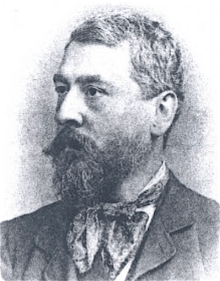
Thomas Edward Collcutt was born in Oxford, England, on 16 March 1840 and was articled to Richard W. Armstrong in London in 1856. After completing his articles he worked as an assistant to Alexander Mills and James Murgatroyd of Mills & Murgatroyd, George Edmund Street (1824-1881) , and to Philip Causton Lockwood in Brighton, Sussex, in 1867.
Collcutt established his own independent practice in London in 1869. He was briefly in partnership with H. Woodzell, and, from 1906 until his retirement in the early 1920s, with Stanley Hinge Hamp (1877-1968) as Collcutt & Hamp
Collcutt was elected a Fellow of the Royal Institute of British Architects (FRIBA) in 1879 and was President of the Royal Institute of British Architects (PRIBA) in 1906-08. He was awarded the Grand Prix for Architecture at the Exposition Universelle in Paris in 1889, and the King's Gold Medal of the Royal Institute of British Architects in 1902. He exhibited at the Royal Academy in London, the Royal Scottish Academy in Edinburgh and at the Glasgow Institute of the Fine Arts.
His address was 12 Finsbury Place South, London (1873); 17 Essex Street, London 1875); 36 Bloomsbury Square, London (1878, 1914); and 5 Lancaster Place, Strand, London (1891). Colcutt died in Southampton, Hampshire on 7 October 1924.
A biographical file on T. E. Collcutt is available at the Enquiry Desk, Royal Institute of British Architects Library, London
Architectural projects by Colcutt included the Town Hall in Wakefield, Yorkshire (c.1877); the Imperial Institute, Kensington, London (1887-93); Royal English Opera House, Cambridge Circus, London (1889-90); Beckstein Hall (now Wigmore Hall in London (1890); a branch of the City of London Bank on Ludgate Street, London (1890); Wignore Hall, London (1890); Wraysbury Hall, Buckinghamshire (1892); an extension to the Restaurant Frascati on Oxford Street, London (1893);The Croft, Totteridge, Herfordshire, 1895); the Lloyd's Registry of Shipping building on Fenchurch Street, London (c.1900); Burlington Hotel at Boscombe in Hampshire (1902); the John Lewis store on Oxford Street, London (1904); an extension to the Savoy Hotel in the Strand, London (1905); and University Hotel in Endsleigh Gardens, London (1912). He also designed a number of private houses for clients in the London area. In addition, Collcutt designed the Wadia monument in Brookwood Cemetery, Surrey (c.1901); the Pacific & Orient (P & O) Pavilion at the Exposition Universelle et International in Paris (1900); and the interiors of a number of ships for the P & O line, including the 'India' and 'China' (1896), the 'Egypt' and 'Arabia' (1897), the 'Moldovia', 'Mongolia' and 'Mamora' (1903), 'Macedonia' (1904), and 'Morea' and Salsette' (1908). He also designed the royal suite on the SS 'Medina' for the Delhi Durbar (1911).
See also:
Agius, Pauline. British furniture 1880-1915. Woodbridge, Suffolk, England: Antique Collector’s Club, 1978
Andrews, John. Arts and Crafts furniture Woodbridge, Suffolk, England: Antique Collectors’ Club, 2005
Avery, Derek. Victorian and Edwardian Architecture. London: Chaucer Press, 2003
Bremner, G. Alex. ‘’Some Imperial Institute': architecture, symbolism and the ideal of empire in late Victorian Britain, 1887-93’. [Traces the development of the Imperial Institute in London designed by T. E. Collcutt] Society of Architectural Historians. Journal vol. 62, no. 1, March 2003 pp. 50-73
Directory of British Architects 1834-1914. Compiled by Antonia Brodie, et al. Volume 1: A-K. London; New York: British Architectural Library, Royal Institute of British Architects/Continuum, 2001
Forsyth, Alastair. ‘The grand hotel afloat.’ [discusses the P&O Pavilion at the Royal Naval Exhibition, 1891, designed by T. E. Collcutt] Country Life vol. 180, no. 4653, 23 October 1986 p. 1293.
Gere, Charlotte and Whiteway, Michael. Nineteenth-century design: from Pugin to Mackintosh. London: Weidenfeld & Nicholson, 1993
Gray, A. Stuart. Edwardian architecture: a biographical dictionary. London: Gerald Duckworth & Co., Ltd., 1985
Haslam, Richard. ‘Stavordale Priory, Somerset.’ [Discusses changes made to Stavordale Priory by T. E. Collcutt in 1904] Country Life vol. 186, no. 19, 7 May 1992 pp. 60-63
Stamp, Gavin. The English House 1860-1914. Catalogue of an exhibition of photographs and drawings. London: InternationalArchitect and the Building Centre Trust, 1980 p. 22
‘Imperial Institute, South Kensington: competition designs’ [Architect: Thomas E. Collcutt] The Builder vol. 53, 1887 pp. 4, 29, 58-59, 62-63.
‘Imperial Institute, South Kensington: competition designs’ [Architect; T.E. Collcutt] The Builder vol. 53, 1887 pp. 24, 29, 58-59, 62-63
‘Imperial Institute, South Kensington: lecture hall’ [Architect: Thomas E. Collcutt] The Builder 17 august 1895 p.120
‘Obituary’. Architectural Review vol. 56, November 1924 p. 46
‘Obituary’. Builder vol. 127, 17 October 1924 pp. 582, 587, 594
‘Thomas Edward Collcutt, 16 March 1840-7 Oct. 1924. Royal Gold Medallist 1902, P.R.I.B.A. 1906-08. Obituary.’ RIBA Journal vol. 31, 18 October pp. 666-668